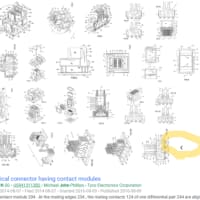US2020067267(JP)
[0013] In order to effectively achieve a high-temperature high-power operation, a quantum-well active layer serving as a luminescent layer is mounted junction-down near a submount substrate where a semiconductor laser element is mounted.
高温高出力動作を実現するためには、発光層となる量子井戸活性層を、半導体レーザ素子が実装されるサブマウント基板に近い側に実装するジャンクションダウン実装を行うことにより、
This reduces a thermal resistance and suppresses a temperature increase of the semiconductor laser element.
熱抵抗を低減し、半導体レーザ素子の温度上昇を抑制することが効果的である。
In this case, a distance between the quantum-well active layer and the submount decreases so as to increase a stress applied to the quantum-well active layer due to a difference in thermal expansion coefficient between a submount material and the semiconductor laser element.
この場合、量子井戸活性層と、サブマウントとの間の距離が近づくために、サブマウント材料と半導体レーザ素子との熱膨張係数の差に起因する量子井戸活性層に生じる応力は大きくなる。
[0133] As illustrated in FIG. 54, semiconductor light emitter 400 disclosed according to Patent Literature 2 is configured such that light-emitting element 402 on GaN substrate 401 is mounted junction-down on convex submount substrate 410 so as to project to GaN substrate 401.
また、特許文献2に係る半導体発光装置400では、図54に示すように、GaN基板401上の発光素子402を、凸状の形状のサブマウント基板410上に、素子のGaN基板401側が凸形状となるようにジャンクションダウンで実装する構成が開示されている。
This configuration is aimed at controlling a stress generated on an active layer and suppressing a deterioration of the active layer.
これにより、活性層に生じる応力を制御し、活性層の劣化を抑制しようとしている。
US2019171091(JP)
[0050] The red semiconductor laser 13R, the green semiconductor laser 13G, and the blue semiconductor laser 13B are each disposed on the heatsink 11, for example, along an X-axis direction, and output the laser beams Lr, Lg, and Lb in directions parallel with one another (e.g., a Z-axis direction).
赤色半導体レーザ13R、緑色半導体レーザ13Gおよび青色半導体レーザ13Bは、それぞれ、ヒートシンク11の上に、例えばX軸方向に沿って配置され、互いに平行方向(例えば、Z軸方向)にレーザ光Lr,Lg,Lbを出射する。
It is to be noted that it is desirable to design the red semiconductor laser 13R, the green semiconductor laser 13G, and the blue semiconductor laser 13B to have a small loss of transmission/reflection in the dichroic prism 16.
なお、赤色半導体レーザ13R、緑色半導体レーザ13Gおよび青色半導体レーザ13Bは、ダイクロイックプリズム16での透過/反射損失の少ない設計とすることが望ましい。
Specifically, it is preferable to arrange the red semiconductor laser 13R, the green semiconductor laser 13G, and the blue semiconductor laser 13B in wavelength order, and as illustrated in FIG. 1, it is preferable to install the red semiconductor laser 13R, the blue semiconductor laser 13B, and the green semiconductor laser 13G in this order or in reverse order (in order of the green semiconductor laser 13G, the blue semiconductor laser 13B, and the red semiconductor laser 13R).
具体的には、赤色半導体レーザ13R、緑色半導体レーザ13Gおよび青色半導体レーザ13Bは、波長順に並べることが好ましく、図1に示したように、赤色半導体レーザ13R、青色半導体レーザ13Bおよび緑色半導体レーザ13Gの順、あるいはその逆(緑色半導体レーザ13G、青色半導体レーザ13Bおよび赤色半導体レーザ13Rの順)に設置することが好ましい。
It is to be noted that an implementation form of the red semiconductor laser 13R, the green semiconductor laser 13G, and the blue semiconductor laser 13B may be junction-up implementation, or may be junction-down implementation.
なお、赤色半導体レーザ13R、緑色半導体レーザ13Gおよび青色半導体レーザ13Bの実装形態は、ジャンクションアップ実装でもよいし、ジャンクションダウン実装でもよい。
US2019035700(JP)
[0092] It should be noted that the semiconductor laser 20 may be mounted on the base substrate 10′ without the sub mount 21.
なおサブマウント21を介さず、半導体レーザ20がベース基板10'に実装されてもよい。
For example, in the case where the semiconductor laser 20 is mounted in a junction-down fashion, a light emitting point is on a lower portion of a chip, so the sub mount 21 is used.
例えば半導体レーザ20がジャンクションダウンで実装される場合には、発光点がチップの下部となるので、サブマウント21が用いられる。
On the other hand, in the case where the semiconductor laser 20 is mounted in a junction-up fashion, the semiconductor laser 20 is mounted on the base substrate 10′ without using the sub mount 21.
一方、半導体レーザ20がジャンクションアップで実装される場合には、サブマウント21を用いることなく、半導体レーザ20がベース基板10'に実装される。
Of course, the way of mounting not limited to those.
もちろんこれに限定される訳ではない。
US2019044303(JP)
[0047] In a case where the semiconductor laser array 1 is mounted with junction-down, electric current which is supplied from an electric power source (not shown in Figure) flows from an electric power source to the first electrode plate 4, the metallic wires 7a, the sub-mount substrate 2 (the electrode plate 21 which is layered on an upper surface), the semiconductor laser array 1, the metallic wires 7b, the second electrode plate 5 and the electric power source so as to oscillate the semiconductor laser array 1.
半導体レーザアレイ1がジャンクションダウンで実装されている場合、電源(図示せず)より供給された電流は、電源→第一電極板4→金属配線7a→サブマウント基板2(上面に積層された電極層21)→半導体レーザアレイ1→金属配線7b→第二電極板5→電源の順に流れ、半導体レーザアレイ1をレーザ発振させる。
US20070253458
7. The integrated laser light emission system of claim 1, wherein the semiconductor laser diode arrays are junction-down mounted to the laser gain medium via a conductive adhesive.
US5086431
In the prior art, as shown in FIG. 1, a semiconductor chip 10 having its lasing junction 12 on its emitting facet 14 is mounted directly on a heat sink 16 with the emitting junction down. The heat sink 16 holds the semiconductor chip 10 so that the lasing junction 12 is close to heat sink 16. The efficiency with which the lasing junction 12 operates is determined in large part by how effectively heat is removed therefrom, accounting for the mounting shown in FIG. 1.
US5837561
FIG. 2 is a graph showing the current/light output relationship for an AS or TS VCSEL mounted "junction up" and a TS VCSEL mounted "junction down";
US7642121
The present invention relates to semiconductor devices, and more particularly to light emitting diodes mounted to a submount in a junction-down configuration.
Junction-down (or “flip-chip”) mounting of LEDs involves mounting the LED onto the submount substrate side up. Light is then extracted and emitted through the transparent substrate. Junction-down mounting may be an especially desirable technique for mounting SiC-based LEDs. Since SiC has a higher index of refraction than GaN, light generated in the active region does not internally reflect (i.e. reflect back into the GaN-based layers) at the GaN/SiC interface. Junction-down mounting of SiC-based LEDs may improve the effect of certain chip-shaping techniques known in the art. Junction-down packaging of SiC LEDs may have other benefits as well, such as improved heat dissipation, which may be desirable depending on the particular application for the chip.


























※コメント投稿者のブログIDはブログ作成者のみに通知されます